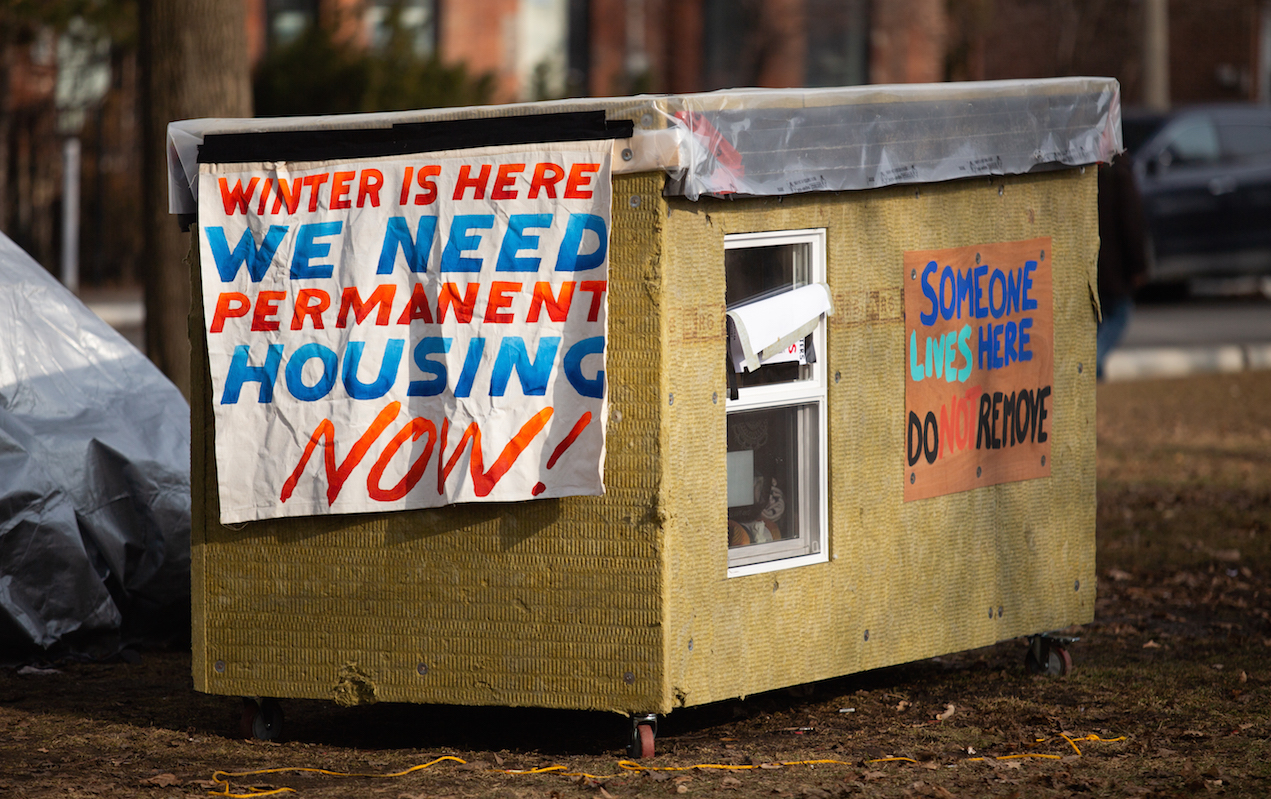Around the world there are tiny home TV shows, tiny home blogs, even tiny home coffee table books (I have one!). Toronto even had a tiny home housing committee led by longtime activist Bonnie Briggs.
My first experience with tiny homes was at Toronto’s Tent City, the famous waterfront encampment that lasted from 1999 to 2002. Homeless people began to build shacks, realizing that winter on the shores of Lake Ontario would be easier to survive within four walls compared to a tent. Eventually there were over 50 structures.
I was part of the Toronto Disaster Relief Committee that leveraged support for the Tent City residents: insulation and roofing work parties, delivery of generators and fuel, installation of woodstoves, funding for portable toilets and tiny prefab homes. The first tiny homes to arrive were from DuraKit, a Canadian company that provided housing in disaster zones and the Far North. We even brought in a duplex DuraKit.
Then John van Nostrand, an architect and urban planner, who has worked internationally on emergency housing, began working with us on a housing upgrade for the entire 140-person community. Working with some of the residents, his team built a prototype called ProHome. We took the completed house on a flatbed truck to a conference and held an open house to show city leaders how this could be a solution to the housing and shelter crisis. The house was then delivered to Tent City for a couple to live in.
This whole story, including the brutal eviction of the encampment is captured in the documentary Shelter from the Storm by Michael Connelly.
The goal of the Tent City advocacy and building of the tiny ProHome was to win housing and, upon the eviction, that is exactly what happened. The residents won a pilot rent supplement program.
In the absence of a substantial national housing program, homelessness and housing precarity have worsened, forcing people to struggle for how to help. I regularly receive well -intentioned — albeit bizarre — suggestions for how people can survive living outside. They range from coats that can turn into sleeping bags, to coffin-like structures a person can crawl into. Today, I was sent information on a German prototype called a “nest” that is solar-powered. From the outside it looks like a space-age cryosleep chamber.
Usually, I respond politely, explaining to people that it is actually real housing that we need and it would be more helpful if they put their energies into advocacy efforts for a national housing program. I argue that people need safe shelter and housing and we shouldn’t let governments off the hook.
Then COVID-19 hit and homeless people faced even worse dangers than the weather.
Encampments grew, encampments were evicted. Over and over Toronto’s shelter-referral line was unable to find shelter spots for people because the system was full. A legal coalition had to take the city to court to achieve two-metre physical distancing in shelters (still not fully achieved). Mask wearing in shelters was only mandated September 4.
Toronto opened numerous shelters and hotels for physical distancing yet continue to operate congregate settings, in one case with only plexiglass dividers. Other municipalities have used hockey arenas and convention centres for mass shelter, neither of which provide protection from an airborne virus.
So, when I heard about Khaleel Seivwright, who was building tiny, structurally sound shelters for homeless people and delivering them one by one, without fanfare, to people living outside, I did a complete 360 in my thinking on tiny shelters.
In September Khaleel created a GoFundMe page that today has surpassed $210,000.
“Hi, my name is Khaleel Seivwright, I am a carpenter and I’ve raised money to rent a garage and buy materials for building durable insulated tiny shelters for homeless people across Toronto who might be living outside this winter. These tiny shelters are designed to be mainly heated by body heat and because of their size and the insulation value of the walls, ceiling and floor just body heat alone should be enough to keep the shelter around 16 degrees Celsius in -20 temperatures. The structures are insulated, water resistant and equipped with a fire/carbon monoxide detector. They have been well received by those who stay in them.”
In a recent video, people living in Toronto tiny shelters describe warmth, safety, ability to lock their door both inside and outside, and better sleep. They say the tiny shelters have saved their life.
Khaleel has worked collaboratively with the front-line Encampment Support Network in Toronto and with homeless people. There is enormous public support for his efforts. The city is not pleased. Not only has the city removed five of his tiny shelters, when the shelters are removed, they are reportedly incinerated. The city has also threatened to ticket Khaleel for the cost of their removal. Yet he continues to build and has started a petition asking the city to not remove the structures.
Similar to the Tent City’s years of advocacy, Khaleel’s efforts are about bringing in disaster relief to save lives and demand governments step up.
It’s not rocket science. As he notes:
“These shelters are not meant to be a permanent solution.
These shelters are not a replacement for the city’s shelter system. They are an alternative for individuals who a) are unable to obtain a shelter bed, b) do not feel safe staying in a shelter (due to COVID or other reasons), or c) have been kicked out of a shelter/hotel and have no other options.
These shelters are needed to protect people from freezing to death during the Canadian winter.
We are not standing in the way of the City’s work towards alternatives that will accommodate all citizens of Toronto.”
Important words. When governments fail, we must hold them accountable.
Cathy Crowe is a street nurse, author and filmmaker who works nationally and locally on health and social justice issues.
Image credit: Image provided by Jeff Bierk




